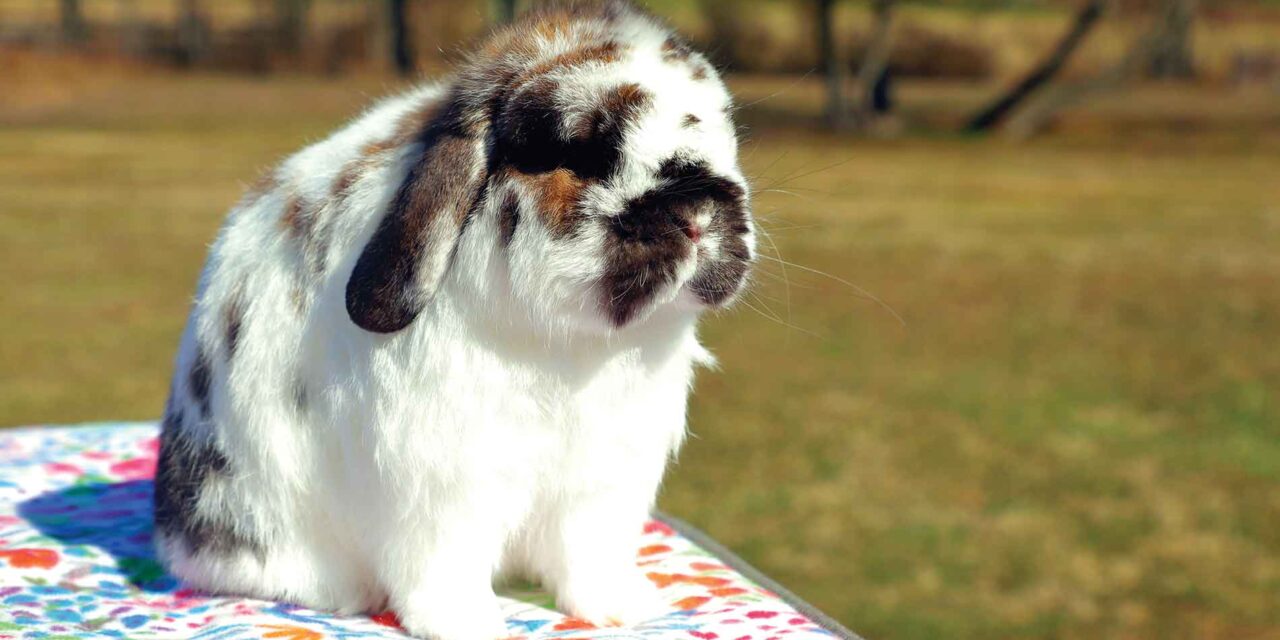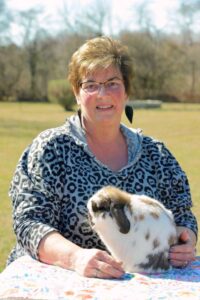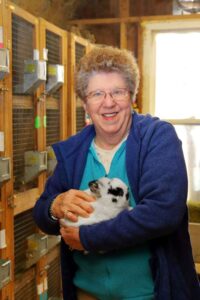by Lois Szymanski, photography by Nikola Tzenov
Raising and Showing Bunnies is a Fun Hobby and Life Education
When we think of rabbits, Bugs Bunny, Peter Cottontail, and the Easter Bunny come to mind, but local rabbit breeders see these long-eared herbivores in a totally different way.
According to Mount Airy breeder Ellie Bonde, there are 51 recognized breeds of rabbit in the United States, each one different from the next in size, coat, color, body shape and other features. There are straight-eared rabbits, lop-eared, long-haired rabbits, velvety soft Rex rabbits, big rabbits like the Flemish Giant and tiny ones like the Netherland Dwarf.
Ellie said her rabbit obsession began with daughters Beth and Rene.
“My oldest daughter [Beth] wanted a bunny for her birthday, so in 1981 we got her a bunny from Dina Knott in Westminster. Dina was 12 and my daughter was a 7-year-old,” Ellie said. “That family took us under their wings. They told us about an upcoming rabbit show and told us to come, so we did.” Ellie laughed. “Beth’s very first rabbit at her very first show was disqualified because it had a white toenail.”
The Bonde family bought more rabbits, setting up cages in a shed on their property. When a new color was approved by the American Rabbit Breeders Association (ARBA) in 1990, Ellie had to have one, and her own collection of rabbits began. Now, with 72 cages and about 75 Netherland Dwarf rabbits, she travels to rabbit shows across the United States.
Ellie’s relationship with ARBA also grew. Formed in 1910, this national rabbit and cavy (guinea pig) breeders club sets the breed standards, and is the umbrella organization for specialty clubs formed for each breed. In the late 1980s Ellie became historian for the national Netherland Dwarf Club. Then, in 1998, ARBA asked her to work with them. Ellie traveled to the national office in Bloomington, Ill., helping organize their collection of publications and memorabilia. When the national headquarters was moved to Knox, Pa, last year, ARBA executive Kevin Whaley and Ellie became co-chairs at the new ARBA museum and library in Knox, where she now works on a rotational basis.
Ellie says raising and showing rabbits is about more than just the animal.
“The rabbits are always happy to see me,” she said. “They seem to appreciate me. They are like therapy — but raising rabbits is more about the friendships formed, and rabbit shows are really about the people. I see friends at these shows that I’ve known for many years, including from states as far away as California, and even Japan and England.”
This is a sentiment fellow rabbit enthusiast Peggy Luers of Westminster shares. She’s been superintendent of the rabbit department at the Carroll County Fair for 10 years and is treasurer of the adult rabbit club in Carroll County. Last year she was inducted into the 4-H Hall of Fame. Her biggest joy, she says, is the children.
“I enjoy helping them find whatever breed they like, watching them show, and seeing their rabbits have babies,” she said. “It is fun to win sometimes, but winning is not important. I’m happy when I produce a good rabbit, but mostly I just enjoy working with the kids.” Ellie agreed.
“There’s a lot of pleasure in helping our youth,” she said. “They are the future of our hobby. Raising rabbits is pretty easy. They are fairly low-maintenance, and it is a healthy activity, one that helped to educate my children, too. I never had to talk about sex-ed. They experienced it in breeding rabbits and raising babies. They learned that some are not born alive, some are born handicapped, and some are perfectly healthy. We have to accept nature’s way. It taught them responsibility, too. They had to feed and water and check on them.”
Ellie said show rabbits range widely in price, adding that the price of a good rabbit starts at about $50, but can go into the hundreds.
“The more you pay, the more you get, as the saying goes,” Ellie said. “Cages cost about $50 each and each rabbit has to have its own cage, then with the purchase of bowls for food and water, I’d budget about $60.”
Like Ellie, Peggy said her kids drew her into the hobby. It started with her son Brent but quickly spread to her daughters Tiffany and Renee — and like Ellie, Dina Knott started them with Netherland Dwarfs. Then, somewhere around 1989, Peggy said she asked her husband Mike if he minded if she started with some rabbits of her own.
“I was still taking Renee to all these shows, so why not?” she recalled.
Renee was raising Netherland Dwarfs and Holland Lops at the time, and Peggy chose Netherland Dwarfs.
Donna Richards raises Holland Lops at her Manchester residence. She shows regularly and is also chair of the youth rabbit department at Maryland State Fair. Donna said her daughter, Ashlee began with rabbits in 1998 as a 4-H project. When Ashlee reached adulthood they both began showing together at open shows. In 2018, when Ashlee stepped out of rabbits, Donna took over the herd. She said the thing she enjoys most is attending rabbit shows.
“Honestly, it is more about the people than the rabbits,” Donna said. “I do enjoy breeding rabbits and showing, but the relationships you develop over the years, not just with Holland Lops but with all rabbits, that is the best part.”
Donna is secretary of the Chesapeake Holland Lop Club and the show secretary for all of their specialty shows.
When asked if they would recommend giving rabbits to children as an Easter gift, all three ladies were in agreement.
“I do not recommend a rabbit for a gift at any time,” Ellie said. “They are going to live for eight to 10 years,” she said, noting that children lose interest fast. “If the child has been asking for a bunny for two years, that might be OK — if you do your research,” she said. “But giving a bunny on a whim is never a good idea. Research and thought should always go into it.”
For those thinking about raising rabbits, Peggy suggests attending a rabbit show.
“Just stand and watch,” she said. “When you are interested in a breed, ask people at the show who is a reputable breeder of that breed. Go visit two or three breeders and look at their set up to see what kind of housing you want for your rabbits. Find out what kind of feed they use, and when you see something new, jot down your questions so you can ask someone and continue to learn more.”
Donna recommended that new breeders begin with the best stock they can afford.
“I suggest a trio of a buck and two does to get started. As you are breeding, you will be making decisions on what stays and what goes. Breeding to the breed standard is always your objective in the show arena.”
“Go and look at all the breeds,” Ellie said. “Some are small, some are big. Some have long hair. Some have floppy ears. There is a wide variety to choose from. If you are interested in showing or going to shows, join ARBA. If not, you might just join the breed club. I want new owners to read about their breed.”
Those interested in rabbits can find a local show by checking out show listings on the ARBA website at: https://arba.net/show-search or visit the Carroll County Fair this summer, held around the last week of July annually. To learn about the two 4-H rabbit clubs in Carroll County, call the Carroll County Extension office at 410-386-2760.




